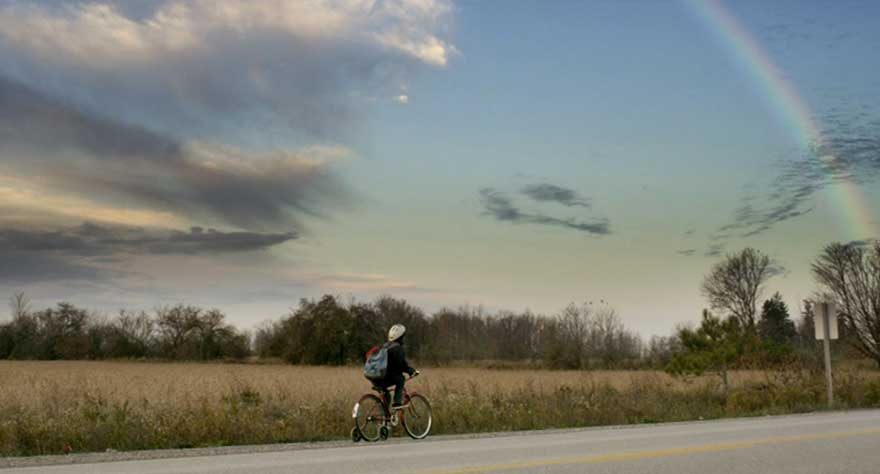
A young man with Down syndrome faces many obstacles on a road trip in this laborious drama.

A young man with Down syndrome faces many obstacles on a road trip in this laborious drama.
According to the National Down Syndrome Society, one in every 691 children born in the US has Down syndrome. That calculates to a collective of over 400,000 people nationally. Hollywood has been paying attention. In addition to casting actors with Down syndrome in key parts in recent hit TV shows like American Horror Story (Jamie Brewer) and Glee (Lauren Potter), 2015’s Where Hope Grows made history as the first major US theatrical release to star an actor with Down syndrome in a leading role (David DeSanctis). The indie film community has taken notice as well, casting Dylan Harman in the title role of the new indie drama The Rainbow Kid.
Eugene (Harman) is a 19-year-old living in an apartment with his mother in Toronto. His passion is rainbows. When tragedy strikes, the Down syndrome sufferer loads his backpack with sandwiches and saved money, hops on his bicycle (training wheels and all), and embarks on a road trip along the back roads of Canada to find the pot of gold at the end of a rainbow he sees outside. On his journey, Eugene meets a collection of individuals, not all of whom share his good nature or his good will.
Writer/director Kire Paputts, making his debut feature with The Rainbow Kid, begins his film with the promise of a hero. Eugene is faced with a life-changing moment that he is not equipped to manage. Still, he remains undaunted. He thinks he knows what is best to do in his situation and he does it—not necessarily without fear, but certainly without hesitation. This is what makes him a hero in the film’s first 10 minutes, and he retains that title throughout the film because, despite considerable adversity, he keeps moving forward, looking for that pot of gold.
This heroism the film’s lone bright spot. Once Eugene hits the road, Paputts abandons all narrative and opts to string together a succession of situations Eugene finds himself getting into and getting out of. While his motivation is strong, his story isn’t a story at all, but rather a series of hurdles he must clear in order to reach his goal.
Eugene’s first major encounter is with a man who “teaches” him to use a bent hanger as a dousing rod to find treasure. That man might be nefarious and Eugene needs to leave. The second major encounter is with an aging rock star who teaches Eugene to dance. That man might be nefarious and Eugene needs to leave. The third major encounter is with a man whose daughter also has Down Syndrome and who will do anything to get into Eugene’s good graces. That man might be nefarious and Eugene needs to leave. And so on, until it isn’t necessarily the people who are a threat to Eugene, but the situations he finds himself in.
With a combination of a lack of narrative, the hero’s drive towards a singular goal, and a steady string of impediments, the entire film feels like an old-school video game, with Eugene as the protagonist. He moves forward, he dodges, he moves forward, there’s a setback, he moves forward, there’s a damsel in distress, he moves forward, he’s injured, etc. Like an old-school video game, the challenges escalate in difficulty as he encounters them. Also like an old-school video game, the challenges become more outlandish as the forward movement progresses. If this were an 8-bit world, it might be fun. However, in a film about a teen with Down syndrome who has suffered a tragedy and is searching for something that doesn’t exist, the circumstances rapidly devolve from quirky to creepy to preposterous.
Like an old-school video game, the repetition becomes monotonous.
There is a sense that one of the purposes of The Rainbow Kid is to demonstrate that a character with a disability can go through a film and struggle with that film’s conflicts no differently than a character without a disability, and amen for that. Life is full of people, some of them disabled, and the movies need to show more of this. But conflicts don’t care about disabilities. Conflicts are conflicts, and if they aren’t believable, it doesn’t matter who is in the lead; those moments simply won’t ring true.
The Rainbow Kid isn’t so much a story of Eugene’s journey as it is a collection of situations Eugene is thrust into, each as unbelievable as the one before it. The lack of narrative would have the film rolling in an endless string of these things, so Paputts must resort to a shocking third-act moment to hurl the story towards resolution instead of leading it to a natural end. That these situations are so outlandish and feature a lead character with Down syndrome, there are times the film feels like it is generating extremes to show that someone with a disability can deal with extremes. That’s not telling a story, that’s forcing a situation, and when the subject of that situation has a disability, it feels like the circumstance has been manufactured to garner additional sympathy. Once that happens, and it happens early here, the film is lost.